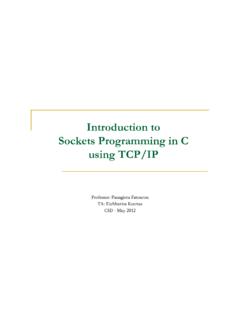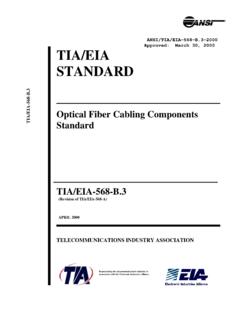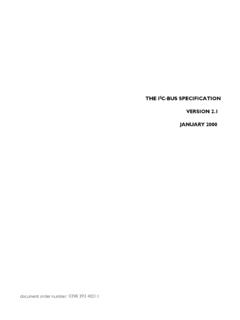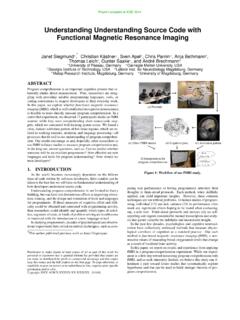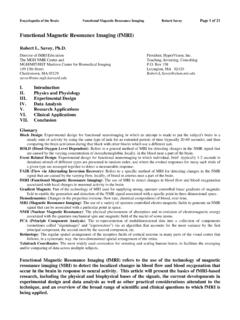Transcription of Functional Magnetic Resonance Imaging fMRI
1 Functional Magnetic Resonance ImagingfMRIE leftherios GaryfallidisMS Student Brain & MindUniversity of CreteMenu Introduction Some NMR Physics fMRI Hardware What fMRI really shows - BOLD Method Positives and Negatives of BOLD fMRI not BOLD Methods Discoveries and Results fMRI fMRI Software fMRIData fMRI Analysis fMRI Visualization Fusion of Medical Imaging The future of fMRIThe Oxford physiologist Charles Sherrington made the observation that when a small area of exposed cat brain was stimulated electrically there is a flush of red blood. This increases the blood supply to the brain locally, ensuring an adequate supply of oxygen to regions working harder in !!So, if we could measure the amount of oxygenated blood in a specific area we could have a measure of the underlined neural activity at this has a lot of water molecules and water molecules have a lot of hydrogen atoms that we can measure using what about oxygenation ?
2 Oxygenation can be shown by T2*. Lets see why .. At an Exponential ratedefined by a certain formula This formula contains a different Time constant T2 Signal intensity decreases with decreasing T2 The T2 rates are different for different tissues The observed signal decay T2 is fast: a few msec to tens of msec Spins begin to (relaxation):What Happens when the additional Magnetic field is turned off?Caudate Nucleus(T2=100ms)CSF(T2=2000ms)Corpus Callosum(T2=90ms)T2 Weighted ImageT2 Weighted Image In the real world, the NMR signal decays faster than T2would predict. There are many factors creating imperfections in the homogeneity of a Magnetic field. Every tissue has a different Magnetic susceptibility which distorts the field at tissue borders, particularly at air/tissue interfaces.
3 The sum total of all of these random and fixed effects is called T2*To sum up, Relaxation:Hardware the basically the same as for simple MRIP rice about million $ for TeslaThe power of 3-Tesla (3T) MRI technology: "The Magnetic strength is about 60,000 times as strong as Earth's Magnetic field." The magnet is supercooled ~ -270 Planar Imaging 64x64 or 128x128 30 to 50 ms per slice 2 to 6 s per volumeEPI & FLASH Two Methods for Pulse Sequence GenerationThe job of the particular pulse sequence is to navigate through the necessary (kxand ky) coordinates so that a signal can be collected at each point in Low Angle Shot 256x256 or 512x512 resol. to 10 s per slice 60 to 240 s per volumeUltra-fast BOLD fMRI Block paradigmWhich consists of alternated periods of activation (or task A) and rest (or task B).
4 Each task is of roughly equal duration, typically the range 20-30 s. Single-event paradigmMuch shorter periods of activation, alternated with longer periods of rest. Duration of activation can be about 6 these time scales, why does one need ultra fast fMRI?The answer relies in signal stability over time. Signal Instabilities: Cardiac Cycle Respiratory motion Head motionUltra Fast Methods: Half-Fourier SENSE (Sensitive Encoding) SMASH (simultaneous acquisitionof spatial harmonics) UNFOLDWhy T2* and not T1?MRI scanner is tuned to resonate and image hydrogen atoms as in conventional MRI; however, T2*-weighted images are performed which take advantage of the fact that deoxygenated hemoglobin is Magnetic whereas oxygenated hemoglobin is not. Because of the Magnetic properties of the unflipped Magnetic deoxyhemoglobin molecule which causes rapid dephasing, T2* signal is retained longer in a region when it has more oxygenated blood.
5 Thus, an area with more oxygenated blood will show up more intense on T2*-weighted images compared to when there is less oxygenated blood around. fMRI-BOLD paradigms generally have several periods of rest alternating with several periods of activation. Images are then compared over the entire activation to the rest periods. Images over the first 3 to 6 seconds of each period are generally discarded due to the delay in hemodynamicresponse. Alternating paradims are used because the signal intensity generated by the MRI scanner drifts with of fMRI Experiments fMRI-BOLD is best used for studying processes that can be rapidly turned on and off like language, vision, movement, hearing, and memory. The study of emotion is hampered by its slow and variable onset and its inability to be quickly reversed.
6 Some have, however, succeed in using this technique to study fear (Whalen et al.)Neuronal activity results increasein oxygen consumption owing to increased metabolic After a delay of ~2 secs, alarge increase in local blood flow. which overcompensates for the amount of oxygen being extracted3. Local increase in cerebralblood volumeThe increase in bloodoxyhaemoglobinis what we measure in fMRIThis is called theBOLD(BloodOxygenLevel Dependent) response. (Ogawa et al. 1990)Dr. Seiji OgawaBOLD(Blood OxygenLevelDependent)contrast Takes advantage of the different Magnetic properties ofoxyhemoglobin(HbO) anddeoxyhemoglobin(Hb)Hb isparamagneticand introduces an inhomogeneity into the nearby Magnetic field, whereas HbO is weakly diamagneticand has little activity local blood flow increases overcompensatingfor oxygen consumption oxygen level in venous blood is elevated larger MR exactly does fMRI-BOLD tell us?
7 From sluggish Haemodynamic response to inferences on neural activity The central assumption:the fMRI signal is approximately proportional to some measure of the local neural activity, averaged over several millimeters and several seconds. This is sometimes referred to as thelinear transform model fMRI signalaltered neuronal activitychanges in local haemodynamics How the three are related is unclear (Buckner, 2002)Altered neuronal activity Changes in local haemodynamics: - need for glucose?- For oxygen? - Some combination of both? Various conflicting bits of evidence In this talk: altered neuronal activity fMRI signal (the linear transform model)(Heeger & Ress, 2002) If the linear transform model were satisfactory, this would be great (!): it would mean we could reliably estimate the underlying neural activity from the Haemodynamic Response Function (HRF) But can we?
8 Most studies simply assume we can; if the model weren t a good approximation, this would make HRF measurements worthless This is important because some fMRI and neurophysiology experiments have yielded conflicting resultsThings the fMRI signal MAY reflect (but we don t know): Firing rates of the local neuronsbut also activity that doesn t evoke spikes: Sub-threshold activity Simultaneous excitation and inhibition Modulatory inputs ( top-down andfeedback from higher cortical areas)and other effects: Changes in neuronal synchrony without a concomitantchange in mean firing rate Large changes in the firing rates of a few neurons ORsmall changes in the firing rate of many neurons To estimate the validity of the linear transform model, it is necessary to see how the fMRI signal correlates with measures of neural activity.
9 But doing this is not so straightforward The relationship of fMRI data and neural activity depends on a few factors:1. How Neural activity is measured and quantified: fMRI: simultaneous activity ofMANY neurons in aLARGE region of cortex (millimeters) over aLONG period (seconds). What component of the neural activity most predicts the fMRI signal? Average firing rate of all / a subpopulation of neurons? Degree of synchronous spiking? The Local Field Potential (LFP), believed to reflect dendritic currents? The Multi Unit Activity (MUA), believed to reflect spiking near the electrode tip? The current source density? Some measure of local average synaptic activity? Some measure of subthreshold electrical activity? All the above may correlate with each other under some circumstances, but can also vary independently of each other.
10 Logothetis (Nature, 2001): simultaneous fMRI, LFPs and MUAs in rats. Concluded that BOLD fMRI signals reflect the input and intracortical processing of a given area rather than its spiking output. 2. fMRI acquisition technique BOLD(BloodOxygenLevel Dependent), the most common, provides a mixed signal dependant on: bloodFLOW bloodVOLUME bloodOXYGENATION. Variations on the technique can be used to emphasize or de-emphasize one or another of these components:- Pefusion-based fMRI blood flow- Injections of various compounds blood volume- Diffusion-based fMRI cell swelling (after excitation)3. Experimental protocol & data analysis Early days of fMRI: worry that the signal arises entirely/mostly fromlarge draining veins misleading on localization For example,visual stimuli at nearby locations activity in nearby (but distinct) loci in V1 But if the fMRI signal were only evident in a large vessel draining blood from V1, The activity from both points would seem to occur in the location of that vesselPositives & Negatives of fMRIP ositives Potential for high temporal and spatial resolution Lacks radioactivity and most techniques are noninvasive Can be repeated multiple times Performed on increasingly common state-of-the-art MRI scanners Better temporal resolution than PETN egatives Extremely sensitive to head movements Awkward environment for emotional paradigms Contraindications.
